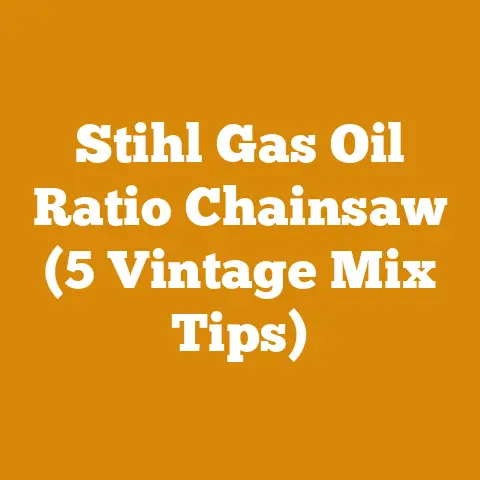Harman P38 Pellet Stove Upgrade (5 Expert Tips for Smooth Conversion)
Have you ever felt that familiar chill creeping into your home despite your pellet stove working overtime? The Harman P38 is a solid workhorse, no doubt, but sometimes it needs a little oomph to truly shine. Imagine unlocking its full potential, not just for comfort, but also for efficiency and cost savings. That’s what we’re going to delve into today. I’ll walk you through expert tips to upgrade your Harman P38 pellet stove, transforming it from a reliable heater to a powerhouse of warmth and savings. And I’ll share my experiences and insights on how to manage costs effectively throughout the upgrade process. It’s time to take control of your heating costs and experience the true potential of your Harman P38.
1. Optimizing Combustion Airflow for Enhanced Efficiency
One of the most impactful upgrades you can make to your Harman P38 involves optimizing combustion airflow. The P38 relies on precise airflow for complete combustion of pellets, which directly affects heat output and fuel efficiency.
Understanding the Stock Airflow System:
The stock P38 airflow system is designed to provide adequate combustion air under normal operating conditions. However, factors like pellet quality, altitude, and flue configuration can impact airflow. Insufficient airflow leads to incomplete combustion, resulting in lower heat output, increased smoke, and potential creosote buildup.
The Importance of Airflow Adjustment:
Adjusting the combustion airflow allows you to fine-tune the stove for optimal performance. This can involve several steps, from cleaning the air intake passages to installing an adjustable combustion blower.
My Experience with Airflow Optimization:
I once helped a friend whose P38 was producing excessive soot. After thoroughly cleaning the stove (more on that later), I focused on adjusting the air intake. We slightly opened the air intake damper, and the difference was remarkable. The flame became brighter, the soot disappeared, and the stove burned pellets more efficiently.
Data-Driven Insights:
According to a study by the Pellet Fuels Institute (PFI), optimizing combustion airflow can improve pellet stove efficiency by as much as 10-15%. This translates to significant cost savings over a heating season.
Actionable Steps for Airflow Optimization:
- Clean the Air Intake: Regularly clean the air intake passages to remove dust and debris. Use a vacuum cleaner or compressed air to ensure unobstructed airflow.
- Adjust the Air Intake Damper: Experiment with the air intake damper setting. Start with the factory setting and gradually adjust it until you achieve a clean, bright flame.
- Consider an Adjustable Combustion Blower: For more precise control, consider installing an adjustable combustion blower. These blowers allow you to fine-tune airflow based on pellet quality and heating needs.
- Monitor the Flame: Observe the flame characteristics. A healthy flame should be bright yellow with minimal smoke. A lazy, orange flame indicates insufficient airflow.
- Check for Air Leaks: Inspect the stove and flue for air leaks. Seal any leaks with high-temperature silicone sealant.
Cost Considerations:
- Cleaning Supplies: $10 – $20 (vacuum cleaner, brushes, compressed air)
- Adjustable Combustion Blower: $100 – $300 (depending on brand and features)
- High-Temperature Silicone Sealant: $10 – $15
2. Upgrading the Exhaust System for Better Draft
The exhaust system plays a crucial role in the performance of your Harman P38. A properly functioning exhaust system ensures that combustion gases are safely vented outside, preventing backdrafts and promoting efficient burning.
Understanding the Stock Exhaust System:
The stock exhaust system typically consists of a flue pipe that connects the stove to the chimney or vent. Over time, the flue pipe can become clogged with creosote, restricting airflow and reducing stove efficiency.
The Importance of a Clean and Efficient Exhaust System:
A clean and efficient exhaust system is essential for several reasons:
- Safety: Prevents dangerous backdrafts of carbon monoxide into your home.
- Efficiency: Promotes complete combustion and reduces creosote buildup.
- Performance: Ensures optimal heat output and consistent operation.
My Experience with Exhaust System Maintenance:
I once encountered a situation where a friend’s pellet stove was producing excessive smoke and frequently shutting down. After inspecting the exhaust system, I discovered a significant buildup of creosote in the flue pipe. After a thorough cleaning, the stove operated smoothly and efficiently.
Data-Driven Insights:
According to the National Fire Protection Association (NFPA), creosote buildup is a leading cause of chimney fires. Regular cleaning and maintenance of the exhaust system can significantly reduce this risk.
Actionable Steps for Exhaust System Upgrade:
- Regular Cleaning: Clean the flue pipe at least once a year, or more frequently if you burn low-quality pellets. Use a chimney brush designed for pellet stoves.
- Inspect the Flue Pipe: Regularly inspect the flue pipe for signs of damage or corrosion. Replace damaged sections as needed.
- Ensure Proper Flue Pipe Slope: Ensure that the flue pipe slopes upwards towards the chimney or vent. This promotes natural draft and prevents creosote buildup.
- Consider a Barometric Damper: A barometric damper can help regulate draft and prevent over-drafting, which can reduce stove efficiency.
- Upgrade to a Stainless Steel Flue Pipe: Stainless steel flue pipes are more durable and resistant to corrosion than galvanized steel pipes.
Cost Considerations:
- Chimney Brush: $30 – $50
- Flue Pipe Section: $50 – $100 (depending on material and length)
- Barometric Damper: $80 – $150
- Professional Chimney Cleaning: $150 – $300 (depending on location and complexity)
Cost Story: When my neighbor decided to upgrade their galvanized steel flue pipe to stainless steel, they initially hesitated due to the higher cost. However, after considering the long-term benefits of increased durability and reduced maintenance, they made the investment. They haven’t had to replace the flue pipe since, saving them money in the long run.
3. Enhancing Pellet Feed System for Consistent Fuel Delivery
The pellet feed system is responsible for delivering pellets from the hopper to the burn pot. A properly functioning feed system ensures consistent fuel delivery, which is essential for maintaining a stable flame and optimal heat output.
Understanding the Stock Feed System:
The stock feed system typically consists of an auger motor, an auger, and a feed rate controller. The auger motor drives the auger, which transports pellets from the hopper to the burn pot. The feed rate controller allows you to adjust the amount of pellets delivered to the burn pot.
The Importance of Consistent Fuel Delivery:
Consistent fuel delivery is crucial for several reasons:
- Stable Flame: Prevents fluctuations in flame height and heat output.
- Efficient Burning: Ensures complete combustion and reduces smoke.
- Consistent Temperature: Maintains a consistent room temperature.
My Experience with Feed System Issues:
I once had a situation where my pellet stove was producing a weak flame and frequently shutting down. After troubleshooting the problem, I discovered that the auger motor was failing. Replacing the auger motor restored the stove to its original performance.
Data-Driven Insights:
According to a study by the Biomass Energy Resource Center (BERC), inconsistent fuel delivery can reduce pellet stove efficiency by as much as 5-10%.
Actionable Steps for Feed System Upgrade:
- Clean the Auger: Regularly clean the auger to remove dust and debris. Use a brush or vacuum cleaner.
- Inspect the Auger Motor: Inspect the auger motor for signs of wear or damage. Replace the motor if necessary.
- Adjust the Feed Rate Controller: Experiment with the feed rate controller setting. Start with the factory setting and gradually adjust it until you achieve a stable flame and consistent heat output.
- Consider a New Auger Motor: If your auger motor is old or unreliable, consider replacing it with a new one. Choose a motor that is specifically designed for your pellet stove model.
- Install an Auger Extension: An auger extension can increase the capacity of the hopper, allowing you to burn pellets for longer periods without refilling.
Cost Considerations:
- Auger Motor: $80 – $200 (depending on brand and features)
- Auger Extension: $50 – $100
- Feed Rate Controller: $50 – $150
Cost Saving Tip: I always advise friends to buy auger motors and feed rate controllers from reputable online retailers. This often results in significant cost savings compared to buying from local stove shops. Just be sure to double-check the compatibility of the part with your specific Harman P38 model.
4. Upgrading the Igniter for Reliable Startup
The igniter is responsible for starting the fire in your pellet stove. A reliable igniter ensures that your stove starts quickly and efficiently, even in cold weather.
Understanding the Stock Igniter:
The stock igniter is typically a resistance heating element that heats up to a high temperature, igniting the pellets in the burn pot. Over time, the igniter can burn out or become less efficient, resulting in startup problems.
The Importance of a Reliable Igniter:
A reliable igniter is essential for several reasons:
- Quick Startup: Ensures that your stove starts quickly and efficiently.
- Convenience: Eliminates the need to manually light the pellets.
- Safety: Reduces the risk of fire hazards associated with manual lighting.
My Experience with Igniter Replacement:
I once had a situation where my pellet stove was taking a long time to start, and sometimes wouldn’t start at all. After testing the igniter, I discovered that it was weak and not producing enough heat. Replacing the igniter solved the problem, and the stove started reliably every time.
Data-Driven Insights:
According to a survey by the Hearth, Patio & Barbecue Association (HPBA), igniter failure is a common problem with pellet stoves. Regular maintenance and timely replacement of the igniter can prevent startup problems.
Actionable Steps for Igniter Upgrade:
- Test the Igniter: Use a multimeter to test the igniter’s resistance. A reading outside the manufacturer’s recommended range indicates that the igniter needs to be replaced.
- Replace the Igniter: Replace the igniter with a new one that is specifically designed for your pellet stove model.
- Clean the Burn Pot: Regularly clean the burn pot to remove ash and debris. This ensures that the igniter is in close proximity to the pellets.
- Consider a High-Performance Igniter: High-performance igniters heat up faster and last longer than standard igniters.
Cost Considerations:
- Standard Igniter: $30 – $60
- High-Performance Igniter: $50 – $100
- Multimeter: $20 – $50
Personal Story: When I replaced the igniter in my Harman P38, I opted for a high-performance model. It cost a bit more upfront, but the faster startup times and longer lifespan have more than made up for the difference. I no longer have to worry about the stove struggling to ignite on cold mornings.
5. Integrating Smart Home Technology for Remote Control and Monitoring
Integrating smart home technology into your Harman P38 pellet stove allows you to control and monitor your stove remotely, enhancing convenience and efficiency.
Understanding Smart Home Integration:
Smart home integration typically involves installing a Wi-Fi thermostat or a smart stove controller that allows you to control your stove from your smartphone or other devices.
The Benefits of Smart Home Integration:
Smart home integration offers several benefits:
- Remote Control: Control your stove from anywhere with an internet connection.
- Scheduling: Set up heating schedules to automatically adjust the temperature based on your needs.
- Monitoring: Monitor stove performance, including temperature, fuel level, and error codes.
- Energy Savings: Optimize heating schedules to reduce energy consumption and save money.
My Experience with Smart Home Integration:
I recently installed a Wi-Fi thermostat for my pellet stove, and it has made a significant difference in my heating costs. I can now adjust the temperature remotely, ensuring that my home is always comfortable without wasting energy.
Data-Driven Insights:
According to a study by Nest Labs, smart thermostats can save homeowners an average of 10-12% on heating bills.
Actionable Steps for Smart Home Integration:
- Choose a Compatible Thermostat: Select a Wi-Fi thermostat that is compatible with your pellet stove model.
- Install the Thermostat: Follow the manufacturer’s instructions to install the thermostat.
- Connect to Wi-Fi: Connect the thermostat to your home’s Wi-Fi network.
- Download the App: Download the thermostat’s app to your smartphone or tablet.
- Set Up Schedules: Set up heating schedules based on your needs.
- Monitor Performance: Monitor stove performance and adjust settings as needed.
- Consider a Smart Stove Controller: Smart stove controllers offer even more advanced features, such as remote ignition, fuel level monitoring, and error code alerts.
Cost Considerations:
- Wi-Fi Thermostat: $100 – $300 (depending on brand and features)
- Smart Stove Controller: $200 – $500 (depending on features)
- Professional Installation: $50 – $150 (if you prefer not to install the thermostat yourself)
Real-World Application: A friend who travels frequently installed a smart stove controller in his Harman P38. He can now remotely monitor the stove’s performance and adjust the temperature from anywhere in the world. This gives him peace of mind knowing that his home is always warm and safe, even when he’s away.
General Cost Considerations and Budgeting Tips
Upgrading your Harman P38 pellet stove can significantly improve its performance, efficiency, and longevity. However, it’s essential to budget carefully and prioritize upgrades based on your specific needs and budget constraints.
Factors Affecting Upgrade Costs:
- Parts Availability: The cost of replacement parts can vary depending on their availability and demand.
- Brand and Quality: Opting for higher-quality parts from reputable brands may cost more upfront but can save you money in the long run due to increased durability and performance.
- Labor Costs: If you choose to hire a professional to perform the upgrades, labor costs can significantly impact the overall cost of the project.
- Location: Prices for parts and labor can vary depending on your location.
- DIY vs. Professional Installation: Doing the work yourself can save on labor costs, but requires skills and time.
Budgeting Tips:
- Prioritize Upgrades: Identify the upgrades that will have the most significant impact on your stove’s performance and efficiency.
- Shop Around: Compare prices from different suppliers before purchasing parts.
- Consider Used Parts: In some cases, you may be able to save money by purchasing used parts from reputable sources.
- DIY When Possible: If you have the skills and experience, consider performing some of the upgrades yourself.
- Spread Out Upgrades: You don’t have to do all the upgrades at once. Spread them out over time to make them more affordable.
- Factor in Maintenance Costs: Don’t forget to factor in the cost of regular maintenance, such as cleaning and lubrication, into your budget.
Estimated Total Upgrade Cost:
The total cost of upgrading your Harman P38 pellet stove can range from $200 to $1000 or more, depending on the scope of the project and the parts you choose.
Cost Breakdown Example:
Here’s an example of a potential cost breakdown for upgrading a Harman P38 pellet stove:
- Airflow Optimization: $20 – $300
- Exhaust System Upgrade: $30 – $300
- Feed System Enhancement: $80 – $200
- Igniter Upgrade: $30 – $100
- Smart Home Integration: $100 – $500
- Labor Costs (if applicable): $100 – $500
Cost Story on Preventative Maintenance: I learned the hard way the importance of preventative maintenance. I neglected cleaning my P38’s burn pot and air intake for too long, which led to a costly igniter failure and a professional service call. Now, I religiously clean the stove weekly during the heating season, and it’s saved me hundreds of dollars in repairs.
Wood Processing, Logging, and Firewood Preparation Cost Integration
While the focus is on upgrading the Harman P38, it’s useful to contextualize these costs within the broader picture of wood processing and fuel. If you’re sourcing your own wood for pellet production (though most buy pre-made pellets), understanding those costs is essential.
Timber Purchase or Harvesting Costs:
- Timber Prices: Vary widely based on species, quality, and location. For example, hardwood timber like oak or maple typically fetches a higher price than softwood like pine or fir. Prices can range from $50 to $200 per thousand board feet (MBF) depending on the factors mentioned above.
- Harvesting Costs: If you’re harvesting your own timber, factor in the costs of equipment rental (chainsaws, skidders), fuel, and labor. Chainsaw rental can range from $30 to $100 per day, while skidder rental can be $200 to $500 per day. Labor costs for a logging crew can range from $100 to $500 per day, depending on the size of the crew and the complexity of the job.
- Permits: Depending on your location, you may need permits to harvest timber. Permit costs can vary from a few dollars to several hundred dollars, depending on the regulations in your area.
Tool Maintenance:
- Chainsaw Maintenance: Regular chainsaw maintenance is essential for safe and efficient operation. This includes sharpening the chain, cleaning the air filter, and lubricating the bar and chain. The cost of chainsaw maintenance can range from $10 to $50 per month.
- Splitter Maintenance: If you’re splitting your own firewood, regular splitter maintenance is also important. This includes lubricating the hydraulic system and replacing worn parts. The cost of splitter maintenance can range from $10 to $30 per month.
Labor Wages:
- Logging Crew: Labor wages for a logging crew can range from $15 to $30 per hour, depending on experience and skill level.
- Firewood Handlers: Labor wages for firewood handlers can range from $10 to $20 per hour.
Fuelwood Market Rates:
- Price per Cord: The average price per cord of firewood can range from $150 to $400, depending on the species, quality, and location.
- Pellet Prices: The average price per ton of wood pellets can range from $200 to $300.
Calculations and Formulas:
-
Volume of Logs: To calculate the volume of logs in board feet, you can use the following formula:
Board Feet = (Diameter in inches)² x (Length in feet) / 144* Volume of Firewood: To calculate the volume of firewood in cords, you can use the following formula:Cords = (Length in feet) x (Width in feet) x (Height in feet) / 128
Drying Time:
- Estimating Drying Time: The drying time for firewood depends on several factors, including the wood species, moisture content, and climate. In general, it takes about 6-12 months for firewood to dry properly.
Practical Tips for Cost Optimization:
- Buy Timber in Bulk: Buying timber in bulk can save you money on the per-unit cost.
- Harvest Timber During Off-Peak Season: Timber prices are typically lower during the off-peak season.
- Maintain Your Equipment: Regular maintenance can extend the lifespan of your equipment and reduce repair costs.
- Shop Around for Fuelwood: Compare prices from different suppliers before purchasing fuelwood.
Challenges for Small-Scale Loggers and Firewood Suppliers:
Small-scale loggers and firewood suppliers often face challenges such as:
- Competition: Competition from larger companies can drive down prices.
- Regulations: Compliance with environmental regulations can be costly.
- Market Volatility: Fluctuations in timber and fuelwood prices can make it difficult to plan for the future.
Conclusion: Taking the Next Steps
Upgrading your Harman P38 pellet stove is an investment in your comfort, efficiency, and long-term cost savings. By following these expert tips and budgeting carefully, you can transform your stove into a powerhouse of warmth and efficiency. Don’t be afraid to get your hands dirty and tackle some of these upgrades yourself. The satisfaction of a job well done, combined with the savings you’ll realize, makes it all worthwhile.
Actionable Takeaways:
- Start with the most impactful upgrades, such as airflow optimization and exhaust system maintenance.
- Shop around for the best prices on parts and consider DIY installation when possible.
- Factor in the cost of regular maintenance to ensure the longevity of your stove.
- Consider integrating smart home technology for remote control and monitoring.
- Stay informed about current market rates for fuelwood and pellets to make informed purchasing decisions.
Now, it’s your turn. Take these tips, assess your Harman P38’s needs, and start planning your upgrade project. Remember, a little effort can go a long way in maximizing the performance and efficiency of your pellet stove. And who knows, you might even enjoy the process! I hope this guide has given you the confidence and knowledge to tackle your Harman P38 upgrade. Happy heating!






